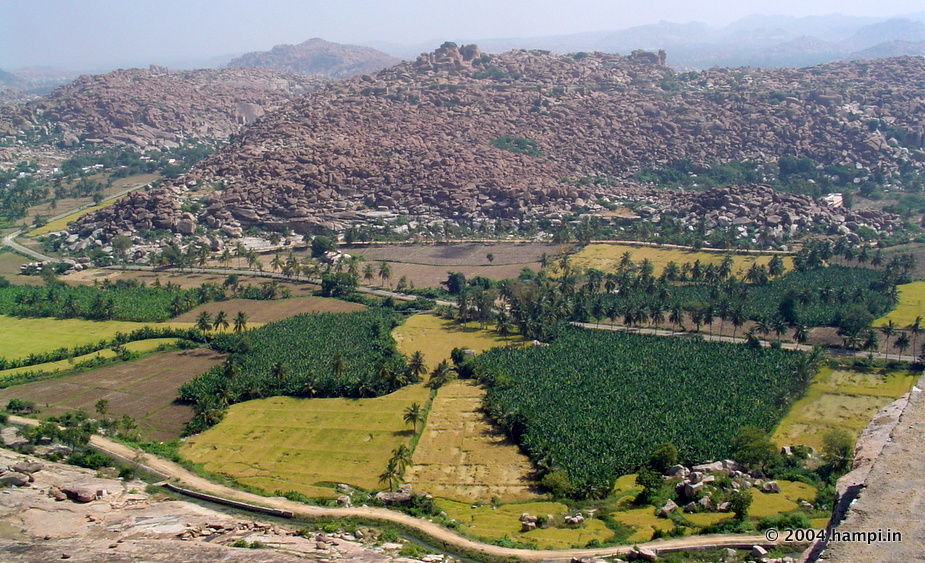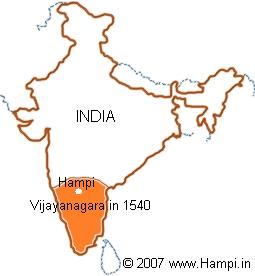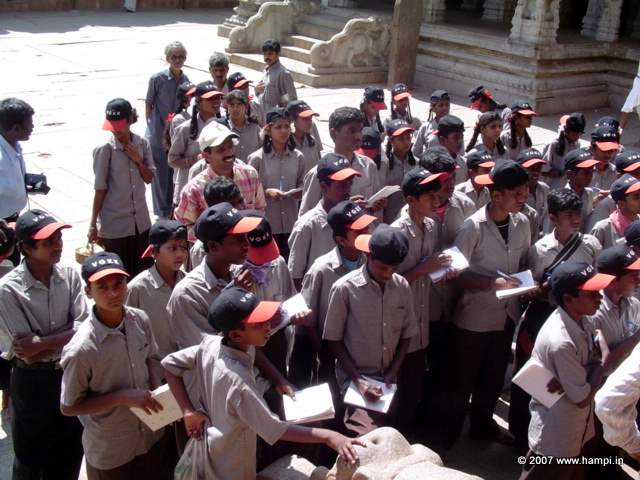History of Vijayanagara

Hampi Landscape
The planes and boulders of Hampi
A
s you skim towards the older portions of Hampi’s history, it appears as if history gives way to folklore and then deftly glides into to mythology .folklore
The typical version Hampi’s history starts with a popular folklore. Two local chieftains, Hakka & Bukka, reports to their guru an unusual sight they saw during a hunting expedition. Their hound chases a hare. Suddenly hare turns courageous and start chasing back the hound!
Vidyaranya - their guru - tells them that the place is so special. Asks them to establish theirs local capital here.
They named the place Vidyaranya, after their guru.
The seed of an empire was sown.
beginning of history
Vidyaranya later came to be called Vijayanagara, literally The City of Victory.
Over the next 300 years (1336 AD – 1646 AD) four dynasties ruled Vijayanagar .
History of Vijayanagara had been a saga of resistance against the northern Sultanates as well as building of its spectacular capital in Hampi.
travel accounts
Domingo Paes, a Portuguese horse trader, who visited Hampi during its heydays wrote in a letter (most likely to João de Barros , the famous Portuguese historian) "The size of this city I do not write here, because it cannot all be seen from any one spot, but I climbed a hill ( most likely the Matunga Hill) whence I could see a great part of it. I could not see it all because it lies between several ranges of hills. What I saw from thence seemed to me as large as Rome, and very beautiful to the sight;
there are many groves of trees within it, in the gardens of the houses, and many conduits of water which flow into the midst of it, and in places there are lakes and the king has close to his palace a palm-grove and other rich-bearing fruit-trees.
Below the Moorish quarter is a little river, and on this side are many orchards and gardens with many fruit-trees, for the most part mangoes and areca-palms and jack-trees, and also many lime and orange trees, growing so closely one to another that it appears like a thick forest; and there are also white grapes.
All the water which is in the city comes from the two tanks of which I have spoken, outside the first enclosing wall."
ascent & descent
The capital was one major trading center. Anything from horses to gems was traded in Hampi. Art and architecture found its special place in Hampi. The rulers were great patrons of art and religion. Most of the kings associated names of their favorite deities with their names.
Some of the kings were renowned for their ambitious projects.
King Krishnadevaraya (1509-1529 AD) of the Tuluva Dynasty stands tall among the Vijayanagara kings. During his regime the empire saw its peak.
By this time Vijayanagara Empire covered the whole of south India and beyond.
The Krishna Temple that you can visit in Hampi was commissioned by him to commemorate the victory over the Gajapathi kings of Utkala (in present day Orissa state).
The waring Deccan Sultanates could finally join together to defeat the Vijayanagara army at Talarikota, a place north of Hampi.
Vijayanagara army suffered heavy loses. The capital city plundered, its population massacred. Treasure hunters ransacked the palaces and temples for months.
oblivion
Kings lost, capital fallen, population fled, Hampi turned into a ghost city. For centuries Hampi remained as a neglected place. This erstwhile metropolitan with more than half a million population slowly turned into a jungle where wild animals roamed freely.
The area came under many kings from time to time with the flow of history. But it was no more considered strategic and hence neglected.
rediscovery
During the colonial period, Hampi evoked some curiosity among the western archaeologists. Robert Sewell’s (1845-1925), seminal work aptly titled as A Forgotten Empire Vijayanagar was a major attempt to narrate the empire that was.
Colonel Alexander John Greenlaw (1818-1870) , a british army officer, took the earliest known photographs of Hampi in 1856.
He took many photos of Hampi using waxed paper coated with silver iodide. None knew about these negatives till it was accidentally discovered in 1980.
In 1917 A.H. Longhurst’s Hampi Ruins Described and Illustrated became the first travel guide for the visitors to Hampi.
UNESCO’s World Heritage Site was conferred to Hampi in 1986.
Currently Hampi's monuments - hundreds of them - are popular among tourists, pilgrims and the area is one of the exotic locations for the Bollywood and local film shootings. Jackie Chan film “Myth” was shot in the Hampi.
Vijayanagara Empire:
| Sangama Dynasty | |
|---|---|
| Harihara Raya | I 1336-1356 |
| Bukka Raya I | 1356-1377 |
| Harihara Raya II | 1377-1404 |
| Virupaksha Raya | 1404-1405 |
| Bukka Raya II | 1405-1406 |
| Deva Raya I | 1406-1422 |
| Ramachandra Raya | 1422- |
| Vira Vijaya Bukka Raya | 1422-1424 |
| Deva Raya II | 1424-1446 |
| Mallikarjuna Raya | 1446-1465 |
| Virupaksha Raya II | 1465-1485 |
| Praudha Raya | 1485 |
| Saluva Dynasty: | |
| Saluva Narasimha Deva Raya | 1485-1491 |
| Thimma Bhupala | 1491- |
| Narasimha Raya II | 1491-1505 |
| Tuluva Dynasty: | |
| Tuluva Narasa Nayaka | 1491-1503 |
| Viranarasimha Raya | 1503-1509 |
| Krishna Deva Raya | 1509-1529 |
| Achyuta Deva Raya | 1529-1542 |
| Sadashiva Raya | 1542-1570 |
| Aravidu Dynasty: | |
| Aliya Rama Raya | 1542-1565 |
| Tirumala Deva Raya | 1565-1572 |
| Sriranga I | 1572-1586 |
| Venkata II | 1586-1614 |
| Sriranga II | 1614-1614 |
| Ramadeva | 1617-1632 |
| Venkata III | 1632-1642 |
| Sriranga III | 1642-1646 |

The Royal insignia of the Vijayanagara
The Royal insignia of the Vijayanagara kings spots 4 elements -Sun, Moon, Dragger and Boar.

The Varaha image on the temple wall of the Varaha Temple that brought the name. This is the Insignia used by the Vijayanagara kings. The Insignia consist of the boar (varaha), dagger , moon (over the dagger) and the sun (not seen in this image).
The Varaha image on the temple wall of the Varaha Temple that brought the name. This is the Insignia used by the Vijayanagara kings. The Insignia consist of the boar (varaha), dagger , moon (over the dagger) and the sun (not seen in this image).

The regions of Vijayanagara influence in 1540 CE
The regions of Vijayanagara influence in 1540 CE

A batch of school students at Virupaksha Temple
A batch of school students at Virupaksha Temple
